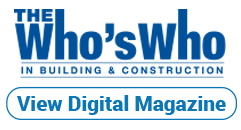Yes, We Do That Too
Whatever you know about Arbon Equipment Corporation...there’s more

Members of the Arbon Equipment Corporation management team (left to right): Ricardo Rodriguez, District Service Manager; Paul Papapetrou, District Sales Manager; Matt Kaminskas, District Installation Manager.

A row of newly installed dock shelters, sectional dock doors and Global Wheel-Lok vehicle restraints.
In the busy world of New Jersey and New York warehouses—engines of commerce that help drive the nation—Arbon Equipment Corporation is the WD-40. Whether it’s a single-dock operation, a large multinational food and beverage client, or a busy distribution center, Arbon Equipment is the start-to-finish force helping manufacturers and distribution hubs stay safe, secure and productive.
“Loading docks are the heartbeat of manufacturing, the unsung major player in the success of any business,” says Paul Papapetrou, District Sales Manager of Arbon Equipment for northern New Jersey, New York City and Long Island. “What good is a game-changing product if you can’t properly receive the materials to build it or properly ship it out to distribute it?”
To the world of product shipping and receiving operations, as 80,000-pound tractor-trailers back up to raised docks, large levelers descend to bridge 4-foot drops, forklifts navigate loaded pallets through narrow spaces, and workers shout and gesture over high-decibel noise… Arbon Equipment brings protection. “Our hallmark is safety,” Paul says, confident in both his company and its parent company, Rite-Hite, a world leader in the manufacture, sale and service of loading-dock equipment and other material-handling solutions—and creator of the original Dok-Lok Vehicle Restraint.
Long Known for Safety
“Until the 1980s, when an 18-wheeler backed up to a warehouse loading dock, the OSHA mandate required a worker to go outside and chock the wheels,” Paul says, referring to the triangular rubber wedge that warehouses keep attached by chain to a nearby wall. “Because if a truck’s brakes fail, it can start to roll away,” he explains. “Or the weight of the forklift can cause the trailer to creep from the dock.”
The problem with the chock system, Paul says, is that it relies on human intervention. “In sleeting rain, an employee who doesn’t feel like getting cold or wet may just pass,” he says. “From what we see and what customers tell us, we also know that many wheel chocks are in poor condition or missing altogether. And we know an 80,000-pound tractor-trailer with monster tires can run right over a chock.”
A truck’s propensity for unplanned movement—also known as trailer creep, trailer tilt or trailer upending—wreaked havoc on safety records until Rite-Hite engineers designed the Dok-Lok Vehicle Restraint. Now as a truck bumps the dock, from below, a vehicle restraint latches onto its rear impact guard (RIG), also called an ICC bar—the stretch of steel originally designed to block a car from going under the trailer. If the RIG is damaged and the vehicle restraint fails to hook onto the dock and in the warehouse, piercing alarms sound and lights flash. On an automatic vehicle restraint system, warehouse doors also shut tight. “Forced safety,” Paul says simply. “A huge part of our technology, like the Rite-Vu Hazard Recognition and Light Communication System, just put safety in the process.”
Today, OSHA counts the vehicle restraint as an alternative to the wheel chock, a choice so effective, Paul says, that Arbon Equipment representatives are required to present it at every site visit and to document in writing the customer’s response. “Forklifts fall off docks all the time during loading and unloading, not to mention the near-misses,” Paul says of a warehouse’s daily hazards. Eventually, something big happens. “We have instances where a year or two after a consultation, a customer will say, ‘We had an accident. Why didn’t you tell us about a vehicle restraint?’ And we say, ‘We did!’ And now it’s on record.”
“Most vehicle restraints now are fully automatic,” Paul adds, because “customers smart enough to take safety to that level usually want to close the circle.” He pauses, then warns, “A false sense of security from a good record is its own hazard. One accident can shut down an entire operation. Yielded productivity and medical expenses can run into hundreds of millions of dollars.”
Corner-to-Corner Products
What companies use Arbon Equipment? Ten years ago, “any organization with a loading dock,” Paul says, but today the market is more nuanced, layered in the best way possible. “Today our products, technology and services have a seemingly infinite variety of solutions to a more complex constellation of customers,” he says. “We can venture into the walls of a pharma company, data center, university, museum, hospital, sports arena—places where people are still finding out all we can do.”
With that phrase “all we can do,” he laughs. Even longtime Arbon Equipment clients, he says, are still learning about all the company can do. “It’s the benefit we bring and the challenge we live with,” he says. “Arbon Equipment is known for loading docks and industrial doors, but even longtime clients are discovering our service, maintenance and repair—and our corner-to-corner energy savers and niche products.”
For example, there’s Rite-Hite’s quick and adaptable Zoneworks Industrial Curtain Walls, semi-permanent walls bypassing the need for Sheetrock and permits. “Space is tight. To build a bigger cooler or close off an area, Zoneworks is a smart, quick fix,” Paul says. “And when you move, you can take it with you.”
Arbon Equipment’s overhead solutions include high-volume, low-speed (HVLS) fans—like a helicopter upside down, Paul says, to chop both heating and cooling costs. For all around a facility, Arbon Equipment offers machine-guarding systems, meeting OSHA mandates to protect employees from equipment with a lot of moving parts. (A pallet or a shrink-wrap machine, for instance, requires fence guarding.)
For the big picture, Arbon Equipment’s newly available Industrial Internet of Things (IIoT) digital platform, Opti-Vu, aggregates data from its smart equipment, opening solutions in even simple trends such as real-time loading dock status. Productivity, energy conservation, safety and effective equipment use all go up. “Owners don’t realize how much profit erodes right under their noses,” Paul says. “Opti-Vu is more than sensors and data. It uses Rite-Hite equipment to help improve operations from even small movements you’d otherwise miss. Companies with optics across every operation have a better chance of getting control of their costs.”
Arbon Equipment’s full service covers maintenance, repair and upgrades for loading-dock equipment and industrial doors. “We provide the products, then help keep them in tip-top shape,” Paul says. Across the U.S., Canada and Australia, Arbon Equipment’s more than 60 offices ensure there are reliable, certified technicians on-site, along with fully equipped trucks, for sporadic repairs or routine planned maintenance.
Fortitude of a Marine, Patience of a Saint
Ask Paul what kind of employee fits best at Arbon Equipment and the pride in his voice intensifies. “Our industry can be frustratingly fickle with unexpected ebbs and flows. You have to have the intestinal fortitude of a marine and the patience of a saint,” he says. “Our territory reps aren’t just sales reps. They’re highly trained and capable project managers who can take a project from cradle to grave and comfortably handle any challenge that comes their way.”
As the oldest cousin in a big family, Paul says, management and family are second nature, probably a big reason why he enjoys his work. “Every day I wake up with a sense that we’re going to go out there and help our customers improve their operations through safety and productivity,” he says. “Nothing makes me happier than seeing my own people or a client master a challenge—seeing the light go on in their head. If I have a part in that, it’s a good day.”


 Login / Register
Login / Register

